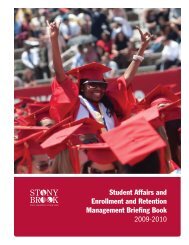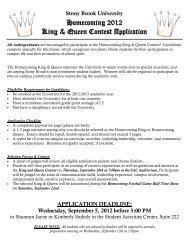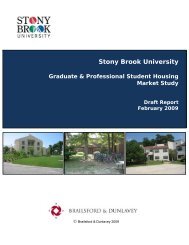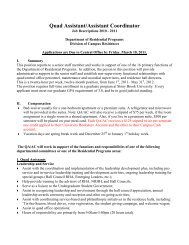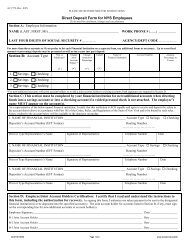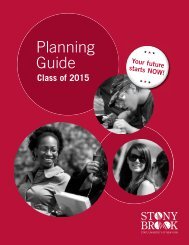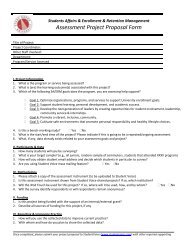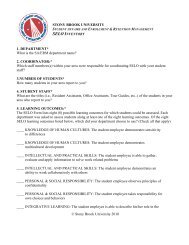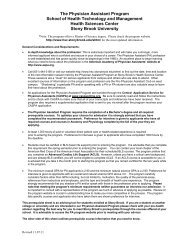PreLaw Guide - Student Affairs - Stony Brook University
PreLaw Guide - Student Affairs - Stony Brook University
PreLaw Guide - Student Affairs - Stony Brook University
Create successful ePaper yourself
Turn your PDF publications into a flip-book with our unique Google optimized e-Paper software.
Reputation<br />
The issue most often discussed by prospective law students, yet the most difficult to define, is “reputation”.<br />
A number of factors contribute to a school’s reputation, including faculty, facilities, career services, reputation<br />
of the parent university, etc. Though a number of law school rankings are available, most factors<br />
evaluated are not quantifiable, and therefore you should not perceive the rankings as accurate or definitive.<br />
Selectivity at law schools, however, is one factor which can be quantified; you can gauge a school's relative<br />
selectivity by comparing the number of applicants accepted to the overall number of applications. The Official<br />
<strong>Guide</strong> to U.S. Law Schools and the Official American Bar Association <strong>Guide</strong> to Approved Law Schools<br />
contain charts and tables of recent admissions cycles at most schools, reflecting the level of selectivity.<br />
Schools can be divided roughly into three groups:<br />
• Schools with national reputations which tend to appear in various "top ten" lists. They draw students<br />
from a national pool and offer geographic mobility to graduates.<br />
• Schools with good regional rep utations which are attended primarily by students from the region, who<br />
may want to remain in the area following graduation, but who may also seek positions throughout the<br />
country.<br />
• Local schools which draw students primarily from the immediate area who want to practice there following<br />
graduation.<br />
For a more detailed discussion of law school reputation, refer to The Official <strong>Guide</strong> to U.S. Law Schools.<br />
Non-Traditional Alternatives<br />
You should be aware that some law schools offer alternatives to fall admission in a full-time law program.<br />
Evening divisions and part-time programs make it possible for students to work and study law simultaneously,<br />
earning a J.D. in four years. A few schools on the quarter system allow students to enter mid-year. Summer<br />
entry and/or summer courses can accelerate the degree program from three to two-and-a-half calendar<br />
years. And finally, some law schools have created summer trial programs, which allow applicants who may<br />
need additional preparation to ready themselves for legal study in time for fall entrance.<br />
Publications and Online Resources<br />
The ABA-LSAC Official <strong>Guide</strong> to ABA-Approved Law Schools is available for applicants to review in the<br />
Academic and Pre-Professional Advising Center. It's also available on-line at LSAC.org. Applicants can order<br />
the <strong>Guide</strong> on-line from LSAC.org or from Barnes & Noble and Amazon.<br />
Catalogs and bulletins published and distributed by law schools are available by contacting the schools by<br />
phone, by U.S. mail, or through their web sites.<br />
The Boston College Online Law School Locator helps applicants identify schools where their LSAT score and<br />
grades are most competitive for admission. www.bc.edu/LawLocator.<br />
School Visits are extremely important in helping an applicant determine if the school is the "right fit" for him<br />
or her. Each school has its own culture. It's intangible but you can feel it during a visit. Do not make your<br />
decision of where to attend law school solely on ranking and prestige.<br />
p 8




